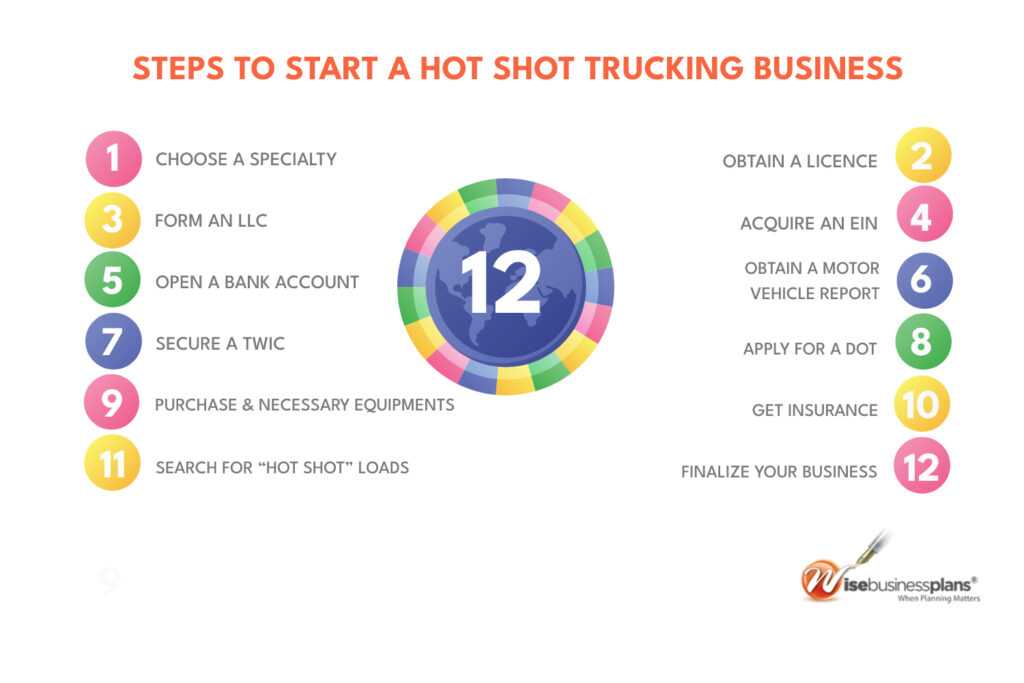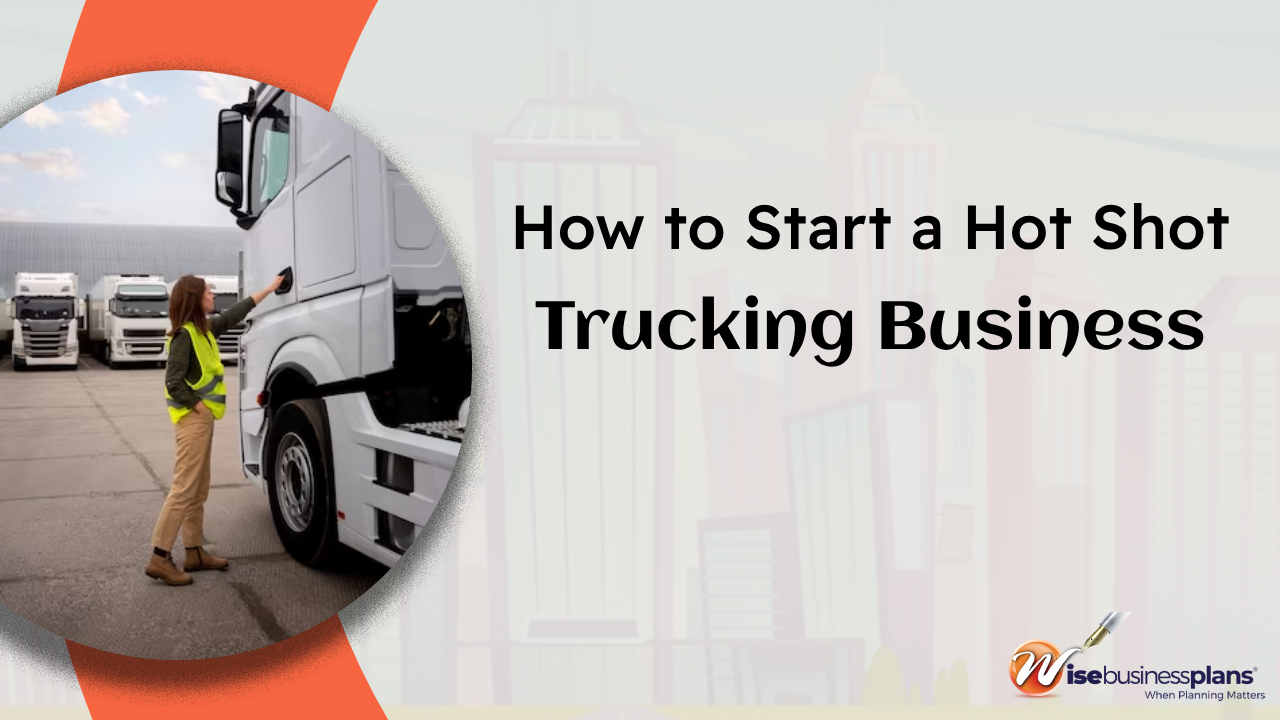How to Start a Hot Shot Trucking Business in 12 Easy Steps
Are you looking to start a hotshot business? This guide is a helpful resource for anyone interested in starting a hotshot trucking business. It outlines the key steps to take, including start-up market research, hotshot trucking business plan, startup cost, obtaining licenses and permits, and acquiring the necessary equipment.
It also emphasizes the importance of establishing shipping partnerships and having insurance and safety protocols in place. In the end, you will find answers to all relevant questions that you may have regarding how to start a hot shot trucking business.
Since WiseBusinessPlans has helped over 500 entrepreneurs and business owners start and grow trucking companies, we are able to prove our information. So, keep on reading to find out what you need to start a hotshot trucking business.
[lwptoc]

12 Steps to Start a Hot Shot Trucking Business
1. Choose a specialty in hot shot trucking.
Concentrating on a certain specialisation of hot shot trucking might help you distinguish your company from competitors and find a valuable market niche. This can be done by analysing the market’s profitability, developments, and trends within the industry.
Hot shot trucking can include a variety of vehicle classes, including Class 3, Class 4, and Class 5 trucks, as well as different types of trailers, such as bumper pull, gooseneck, tilt deck, and dovetail trailers, which are equipped to handle heavier loads and specialized cargo.
When making a choice, state rules, distance, and the type of cargo should all be taken into account.
There are three primary classifications for hot shot trucks:
- Class 3 is for light-duty and small loads
- Class 4 is for medium-duty and larger loads
- Class 5 is for heavy-duty and the largest loads.
- Bumper-pull trailers are connected to the bumper of a vehicle and usually have a lower weight capacity
- Gooseneck trailers have a higher weight capacity and are attached to the bed of the truck by a ball hitch.
- Tilt-deck trailers have a tilting deck, which makes it easier to load and unload machinery, equipment, and vehicles.
- Dovetail trailers have a split deck with a flatbed section and a ramped section, which is suitable for loading heavy cargo, vehicles, or equipment.
Get our professional business plan services now!
2. Obtain a commercial driver’s licence (CDL).
It is important to note that you do not require a Commercial driver’s licence (CDL) as long as the combined weight of the truck, trailer, and cargo does not exceed 10,000 pounds and 26,000 pounds, respectively.
However, additional certifications can be required if you intend to transport specialised cargo, including hazardous items. It is advised to get a CDL at a later stage as your company expands because it is a difficult and drawn-out process.
3. Form an LLC (limited liability Company)
You should form an LLC or another type of firm structure before starting a hotshot business to shield yourself from legal claims. The simplest approach to set up a business is as an LLC, which has many advantages such as
- Less paperwork
- Less personal responsibility
- Favorable tax treatment
Wise business plans is a top-rated Entity forming Company that can help you form an LLC in no time.
4. Acquire an EIN (Employer Identification Number).
For an Employer Identification Number (EIN), which is used to identify your business for tax purposes, you can submit an application to the Internal Revenue Service online.
If you run a sole proprietorship, you should use your Social Security number. You’ll also have to pay taxes on the revenue you generate from your business.
To acquire an Employer Identification Number (EIN) or Tax Identification Number (TIN), these are the steps to take:
- Complete IRS Form SS4 and send it via mail to the correct address.
- Obtain a EIN by reaching out to one of the following entities:
- The local area unemployment office
- The internal revenue service centre
- The state department of labour and industry.
5. Open a business bank account
After getting your EIN the most crucial step is to open a business bank account. Accurate record-keeping is essential for filing your taxes correctly. One important step is to open a separate bank account for your business so that you can clearly distinguish between personal and business finances.
When choosing a bank, make sure to consider the specific needs of your company in terms of features and services offered. You would need to fulfill these Bank requirements in order to apply for a business bank account
6. Obtain a Motor Vehicle Report (MVR)
It is simple to acquire a motor vehicle number in most states, but as there can be possible complications, it is advised to prepare for the MVR ahead of time. Some states provide online alternatives or digital downloads.
Hotshot truck drivers may need to look into any additional specifications. You can get in touch with the department or bureau of motor vehicles in your state to get a copy of your driving history.
To find out how to get a personal copy of your MVR, go to the DMV or BMV website for your state.
7. Secure a TWIC (Transportation Worker Identification Credential).
Having Transportation Workers Identification Credential is not mandatory for hotshot trucking, but it can open up more opportunities for the type of loads you can transport. The TWIC enables access to secure areas like ports and is controlled by the Maritime Transportation Security Act.
You will need a TWIC if you want to transport containers between ports or secure warehouses or engage in drayage trucking. The TSA will conduct a background check and security threat assessment before issuing a TWIC.
Checkout our free business plan examples now!
8. Apply for a DOT (Department of Transportation) number and MC number
You must register your company with the federal government and your state’s Department of Transportation (DOT) in order to drive interstate. A DOT number and MC number will be issued by the FMCSA.
To confirm that the drivers are fit to transport freight, hotshot truck drivers may also need to pass a DOT physical test and carry a medical card.Before you get on the road, be sure you have your commercial driver’s license.
9. Purchase or lease a truck and the necessary equipment
You will require a truck to launch a hotshot trucking company. You have the option of renting or buying one. It is affordable to lease a truck, Although you won’t own the vehicle, leasing gives you access to newer or better equipment.
Purchasing a truck, whether with financing or in cash, gives you ownership of the vehicle and does away with monthly payments, but the cost over time may be higher.
Leasing is a common starting point for hotshot truckers, who eventually move to ownership as their businesses gain more stability and finance.
Depending on the manufacturer, model, and state of the truck, the price of one can range from $20,000 to $60,000, which is a significant price variation. It’s crucial to make an investment in a sturdy truck that can haul huge items.
It is advised to take into account a truck’s fuel efficiency when researching it, as this factor can significantly affect operating costs.
10. Get insurance for the truck
To protect your company and comply with the law, getting insurance is essential when beginning a hot shot truck business. The following insurance companies might offer protection for your hot shot trucks:
Your rental or leasing company may also be able to help you with insurance. When selecting an insurance plan that meets your company’s needs, take into account factors like coverage restrictions, deductibles, and exclusions.
11. Search for “hot shot” loads
Now that everything is set up, you need to start moving your vehicle. The most effective technique to locate nearby loads from reputable and experienced suppliers is to use hotshot load boards.
Use load boards as a tool to find cargo in a certain area. Load boards are online marketplaces that link shippers with trucking firms or independent drivers. some of the most famous load boards are the following:
12. Finalize your Business
Complete your Funding requirements:
There are several funding options for your business that include traditional bank loans, loans backed by the Small Business Administration, government grants, venture capital, crowdfunding, and self-funding through personal savings or the sale of assets.
Loans that are SBA-guaranteed may also be beneficial. Government subsidies and crowdfunding platforms can be a way to fund start-ups but may have conditions or limitations. It also points out that venture funding may not be an ideal option as it might involve giving up ownership stakes for money.
Obtain Business Insurance
Insurance is important for protecting a business, and recommended types include general liability, business property, equipment breakdown, workers’ compensation, property, professional liability, and business interruption insurance, which cover various aspects of harm, loss, or damage to a business, its property, equipment, employees, professional omissions, errors, and closure due to a covered incident.
Set up your team
You will need to hire people as your hot shot truck company expands to fill positions such as drivers, dispatchers, general managers, and marketing leaders. Linkedin and Indeed are online platforms where you can find the candidates against relevant positions.
Get all software required
To manage duties like marketing, sales, and accounting, think about using sector-specific software like ShipWell.
Quickbooks and other web-based accounting tools are accessible to small businesses.
If you are not familiar with basic accounting, it may be advantageous to hire a professional to ensure accuracy. To ensure that your business is running efficiently, remember to keep all of your software updated.
Get ready all marketing materials and advertisement
Make an investment in digital marketing and link your website to social media accounts to raise customers for your company. Making interesting postings for social media sites like Facebook can also help you in this regard.
You should think about designing a professional logo with a tool like Canva or hiring a qualified designer on a marketplace like Fiverr to guarantee that your company has a strong visual identity.
Furthermore, adding your company to local listing websites like Yelp and Google My Business can improve visibility and make it simpler for potential clients to find you when looking for nearby services that are relevant to their needs.
Congratulations on launching your hot-shot trucking career! By following the necessary steps, you are now ready to grow a successful business.

Want to write a business plan?
Hire our professional business plan writers now!
FAQs:
Hot shot trucks are smaller commercial vehicles used to transport urgent cargo on short routes, driven by independent contractors, with pay per mile.
- CJK Transport Company 6. Patriot Freight Group
- JF EXPRESS Fr8 7. VeriTread LLC
- Trinity 3 Logistics 8. ACME truck Line
- A2C Logistics Company 9. Expedited Freight
- Hotshot Final Mile 10. Hazel’s Expedited Freight
Transporting sensitive, single-destination cargo in hot shot trucking often includes using medium-duty trucks with flatbed trailers and a focus on speedy delivery.
- Get CDL (Commercial driver’s licence )
- Get DOT(department of transportation) Number
- Get MC(Motor Carrier)Number
- Get DOT physical and medical certificates
- Get Insurances for trucks, business and other liabilities
- Ensure that a driver logbook is maintained.
- Comply with the regulations set by the DOT regarding driving and rest time,
- Carry a fire extinguisher in the vehicle.
- Have reflectors in place.
- Have the appropriate DOT licence plate and load sticker displayed.
| Expense | Cost |
| LLC incorporation, licences, and permits | $500- $1000 |
| Insurance | $3,500-$4500 |
| Marketing and advertising | $500-$2000 |
| Website and software | $1000-$1200 |
| Pick-up truck | $15000-$40000 |
| Trailer | $8,000-$25000 |
| Other tools and equipment | $600-$1000 |
| Metrics | Information/rates |
| Average Revenue | $2 per mile. |
| Average Cost | $0.78 per mile |
| Gross Profit | $1.22 per mile |
| Annual Revenue | $90,000 |
| Profit | $55,000 |
- There is a Potential for high profits
- There are Opportunities available in various industries
- Flexibility of working independently is a plus.
- The Start-up costs might be high.
- Long working hours and tight deadlines can be a headache.
- There must be strict compliance and rules.
- Hot shot trucking is in demand because it is affordable, quick, and dependable.
- Due to the manufacturing sector’s resurgence, there are more chances than ever.
- Inflation and rising fuel prices are problems.
- Finding qualified drivers is difficult












